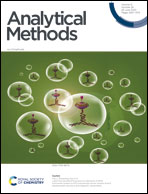Fast, direct and in situ monitoring of lipid oxidation in an oil-in-water emulsion by near infrared spectroscopy†
Abstract
Lipid oxidation has implications on food, cosmetics and other fat containing products. Fatty acid autoxidation alters both the quality and safety of these products. Efficient and fast methods are needed to track lipid oxidation in complex systems. In this study, an oil-in-water emulsion (20% v/v of fish oil stabilized with high oleic sunflower lecithin) was subjected to iron-initiated oxidation. Conjugated dienes (CDs) were measured after fat extraction using a standardized method. Near infrared spectroscopy (NIRS) has been used to record chemical changes occurring during oxidation directly in the emulsion. Variations were noticed in different spectral regions. Partial least squares regression (PLSR) revealed correlations between conjugated diene values and NIRS spectra. High coefficients of determination (R2 = 0.967 and 0.996) were found for calibration and prediction respectively. The CD value was predicted from NIRS spectra with an error of 7.26 mmol eq. LH kg−1 oil (7.8% error). Limits of detection (LOD) and quantification (LOQ) of 4.65 and 15.5 mmol eq. LH kg−1 oil were estimated. NIRS is a rapid and simple method for measuring lipid oxidation (CD value) in an emulsion without prior fat extraction. NIRS can replace the reference methods that use hazardous solvents and consume time. Therefore, NIRS enables in-line monitoring for process and quality control.



 Please wait while we load your content...
Please wait while we load your content...